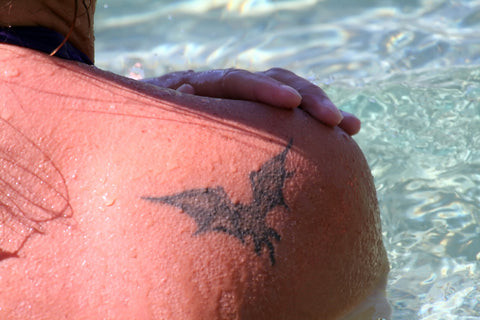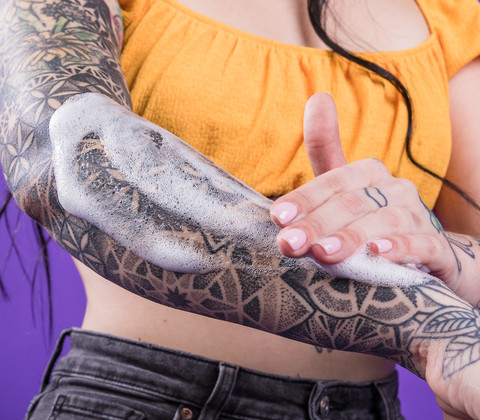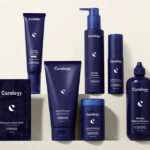Can A Tattoo Get Sunburned? Absolutely, and at tattooat.com, we’re here to help you protect your precious ink. Sunburns can severely damage both fresh and healed tattoos, leading to fading, distortion, and even infection. Fortunately, with the right knowledge and precautions, you can keep your tattoos vibrant and your skin healthy. Keep reading to find out more about sun-damaged tattoos, UV ray effects, and sun protection.
1. What Happens When Your Tattoo Gets Sunburned?
Sunburns on tattoos are no fun, and the consequences vary depending on whether your tattoo is new or fully healed. Understanding these differences is crucial for proper tattoo care.
1.1. New Tattoos and Sunburns
If your tattoo is new, avoid the sun until it’s fully healed, which can take about 12 weeks. Most of the healing happens in the first four weeks, so it’s critical to protect it during this time.
Sunburns can significantly prolong healing, potentially adding several weeks to the process. Blistering sunburns can remove ink, cause scarring, and distort the tattoo’s appearance. While touch-ups are possible, preventing sunburns is the best approach.
 New Tattoo Sunburn
New Tattoo Sunburn
Alt text: Close-up of a newly tattooed arm with visible redness and early signs of sunburn, highlighting the need for immediate protection.
1.2. Healed Tattoos and Sunburns
Even fully healed tattoos can suffer from sun exposure. Sunburns can cause fading and minor distortion. One-time sunburns might not cause noticeable damage, but cumulative sun exposure can lead to gradual fading and a patchy, gray appearance over time.
2. What to Do if Your Tattoo Is Sunburned
Whether your tattoo is new or old, acting quickly is crucial when it gets sunburned. Here’s what you should do:
2.1. Addressing Sunburn on New Tattoos
If your new tattoo gets sunburned, contact your tattoo artist immediately. They can provide specific recommendations and suggestions for care. Honesty is key, as you may need a touch-up later.
Typically, your artist will advise applying aloe vera and hydrating, fragrance-free, dye-free skincare products to soothe and protect the area.
2.2. Treating Sunburn on Healed Tattoos
Treat older tattoos like any other sunburned skin. Sunburn-soothing gels and skincare products are generally safe for use on fully healed tattoos.
Regardless of the tattoo’s age, sunburns can be painful. While many aftercare products contain numbing ingredients, doctors often advise against using numbing products on fresh sunburns. Allow the skin to begin healing on its own before considering numbing sprays to minimize itching during the peeling phase.
3. How to Prevent Sunburns on Tattoos
Prevention is always better than cure. Protecting your tattoos from the sun is simple and effective with the right strategies.
3.1. The Power of Sunscreen
Sunscreen is essential for everyone, especially those with tattoos. Apply a broad-spectrum SPF 30 or higher daily, even on cloudy days or when you don’t plan to spend much time outside.
Don’t forget to apply sunscreen before car rides, as sunlight through windows can still damage your skin. Economical sunscreens work just as well, and spray-on sunscreens are convenient for quick application (avoid them on brand new tattoos). Keep sunscreen in your bag for regular touch-ups, especially after swimming or sweating.
3.2. Protective Clothing
If you prefer not to use sunscreen, wear lightweight, long-sleeved shirts to shield your skin and tattoos from direct sun exposure. As long as the material isn’t too sheer, it offers good protection.
 Tattoo Sun Protection
Tattoo Sun Protection
Alt text: An individual with a full arm tattoo wearing a light-colored, long-sleeved shirt, demonstrating a practical way to protect tattoos from the sun.
4. Understanding the Science Behind Sunburns and Tattoos
To better protect your tattoos, it’s helpful to understand how sunburns affect the skin and tattoo ink.
4.1. The Impact of UV Rays
According to research from Portland State University’s Art Department in July 2025, UV rays can break down the pigment in tattoo ink over time. This is because tattoo ink is deposited in the dermis, the layer of skin beneath the epidermis. When exposed to sunlight, the UV radiation penetrates the skin and affects the ink particles.
4.2. The Role of Melanin
Melanin, the pigment that gives skin its color, helps protect against UV damage. However, tattoos can disrupt the natural melanin production in the tattooed area, making it more susceptible to sunburn. People with lighter skin tones are particularly vulnerable, as they have less melanin to start with.
5. Tattoo Aftercare and Sun Protection
Proper aftercare is crucial for new tattoos, and sun protection is a key part of this.
5.1. Immediate Aftercare Tips
Follow your tattoo artist’s aftercare instructions carefully. These instructions typically include:
- Keeping the tattoo clean and dry
- Applying a recommended ointment or moisturizer
- Avoiding direct sunlight
- Wearing loose clothing to protect the area
5.2. Long-Term Care
Even after your tattoo is fully healed, continue to protect it from the sun. Regular sunscreen use and protective clothing will help maintain its vibrancy and prevent fading.
6. Choosing the Right Sunscreen for Your Tattoo
Selecting the right sunscreen is vital for protecting your tattoo.
6.1. Types of Sunscreen
There are two main types of sunscreen:
- Mineral Sunscreens: Contain zinc oxide and titanium dioxide, which create a physical barrier against UV rays. These are generally considered safer for sensitive skin and tattoos.
- Chemical Sunscreens: Absorb UV rays and convert them into heat, which is then released from the skin. Some people may be sensitive to the chemicals in these sunscreens.
6.2. Key Ingredients to Look For
When choosing sunscreen, look for:
- Broad-spectrum protection
- SPF 30 or higher
- Water resistance
- Fragrance-free and non-comedogenic formulas
7. Common Myths About Tattoos and Sun Exposure
There are several misconceptions about tattoos and sun exposure. Let’s debunk some of the most common ones:
7.1. Myth: Black Ink Is More Resistant to Sun Fading
While it’s true that black ink tends to hold up better than some other colors, it’s not immune to sun damage. All tattoo inks will fade over time with enough sun exposure.
7.2. Myth: Sunburns Only Affect New Tattoos
As mentioned earlier, sunburns can damage both new and old tattoos. While new tattoos are more vulnerable, healed tattoos can still fade and distort with sun exposure.
7.3. Myth: Tanning Beds Are Safer Than Natural Sunlight
Tanning beds emit UV radiation that is just as harmful as natural sunlight. They can cause significant damage to tattoos and increase the risk of skin cancer.
8. The Role of Tattoo Artists in Educating Clients
Tattoo artists play a crucial role in educating clients about tattoo aftercare and sun protection.
8.1. Providing Aftercare Instructions
Reputable tattoo artists provide detailed aftercare instructions to their clients. These instructions should include information on sun protection, cleaning, and moisturizing.
8.2. Offering Product Recommendations
Many tattoo artists recommend specific sunscreens and skincare products that are safe and effective for tattoos.
8.3. Emphasizing the Importance of Long-Term Care
Good tattoo artists stress the importance of long-term care, including regular sun protection, to maintain the vibrancy and integrity of the tattoo.
9. Finding a Tattoo Artist Who Understands Sun Protection
When choosing a tattoo artist, look for someone who is knowledgeable about sun protection and aftercare.
9.1. Asking Questions
Don’t hesitate to ask potential tattoo artists about their aftercare recommendations and their views on sun protection. A knowledgeable artist will be happy to answer your questions and provide helpful advice.
9.2. Checking Reviews and Testimonials
Read reviews and testimonials from other clients to see if the artist emphasizes aftercare and sun protection.
9.3. Visiting the Studio
Visit the tattoo studio to assess its cleanliness and professionalism. A reputable studio will prioritize client education and safety.
10. The Future of Tattoo Protection
Advancements in skincare technology are continuously improving tattoo protection methods.
10.1. Innovative Sunscreen Formulations
New sunscreen formulations are being developed to provide even better protection for tattoos. These include:
- Enhanced UV Filters: Sunscreens with advanced UV filters that offer broader protection against both UVA and UVB rays.
- Antioxidant-Rich Formulas: Sunscreens with added antioxidants to help neutralize free radicals caused by sun exposure.
- Tattoo-Specific Sunscreens: Sunscreens specifically formulated to protect tattoo ink and enhance its vibrancy.
10.2. Smart Textiles
Smart textiles are fabrics that can monitor and protect the skin from UV radiation. These fabrics can be incorporated into clothing to provide an extra layer of sun protection for tattoos.
10.3. Personalized Skincare
Personalized skincare solutions are becoming increasingly popular. These solutions use individual skin assessments to create customized sun protection plans for tattoos.
11. Sun Safety Tips for Tattoo Enthusiasts
To summarize, here are some essential sun safety tips for tattoo enthusiasts:
- Apply broad-spectrum SPF 30 or higher sunscreen daily.
- Wear protective clothing, such as long-sleeved shirts and hats.
- Avoid prolonged sun exposure, especially during peak hours.
- Stay hydrated to keep your skin healthy.
- Follow your tattoo artist’s aftercare instructions carefully.
- Check your tattoos regularly for signs of sun damage.
12. Exploring Tattoo Designs That Complement Sun Protection
Certain tattoo designs and placements can make sun protection easier.
12.1. Placement Considerations
Consider tattoo placement when planning your design. Areas that are easy to cover with clothing, such as the back, chest, or thighs, are less likely to be exposed to the sun.
12.2. Design Elements
Incorporate design elements that can be easily shaded with sunscreen or clothing. For example, a tattoo on the arm can be designed to extend to the shoulder, allowing for better coverage with a shirt sleeve.
13. Tattoo Removal and Sun Damage
Sun damage can complicate tattoo removal.
13.1. Effects of Sun Damage on Removal
Sun-damaged tattoos may require more laser sessions for removal. The fading and distortion caused by sun exposure can make it harder for the laser to target the ink effectively.
13.2. Protecting Tattoos During Removal
Protect tattoos from the sun during the removal process. Sunscreen and protective clothing are essential to prevent further damage.
14. Tattoos and Travel: Sun Protection on the Go
Traveling to sunny destinations requires extra precautions.
14.1. Packing Essentials
Pack plenty of sunscreen, protective clothing, and aftercare products.
14.2. Planning Activities
Plan activities that minimize sun exposure, such as indoor sightseeing or swimming in shaded areas.
14.3. Staying Hydrated
Drink plenty of water to keep your skin hydrated and healthy.
15. Expert Opinions on Tattoo Sun Care
What do the experts say about protecting tattoos from the sun?
15.1. Dermatologists’ Recommendations
Dermatologists recommend using broad-spectrum SPF 30 or higher sunscreen daily. They also advise wearing protective clothing and avoiding prolonged sun exposure.
15.2. Tattoo Artists’ Advice
Tattoo artists emphasize the importance of following aftercare instructions and using high-quality sunscreen. They also recommend regular touch-ups to maintain the vibrancy of the tattoo.
16. The Psychological Impact of Protecting Your Tattoos
Protecting your tattoos is not just about physical health; it’s also about mental well-being.
16.1. Maintaining Self-Esteem
Tattoos can be a source of pride and self-expression. Protecting them from sun damage helps maintain your self-esteem and confidence.
16.2. Reducing Anxiety
Knowing that you’re taking steps to protect your tattoos can reduce anxiety about fading and distortion.
16.3. Fostering a Sense of Control
Taking proactive steps to protect your tattoos gives you a sense of control over your appearance and health.
17. Resources for Further Learning
Numerous resources are available for learning more about tattoo care and sun protection.
17.1. Online Articles and Blogs
Many online articles and blogs provide valuable information on tattoo care and sun protection.
17.2. Books and Magazines
Several books and magazines cover tattoo art, culture, and care.
17.3. Professional Organizations
Professional organizations like the American Academy of Dermatology offer resources on sun safety and skin health.
18. Joining the Tattoo Sun Protection Community
Connect with other tattoo enthusiasts to share tips and experiences.
18.1. Online Forums and Groups
Join online forums and groups dedicated to tattoo care and sun protection.
18.2. Social Media
Follow tattoo artists, dermatologists, and skincare experts on social media for tips and updates.
18.3. Local Events
Attend local tattoo conventions and events to connect with other enthusiasts and learn from professionals.
19. Case Studies: Real-Life Examples of Tattoo Sun Damage
Let’s look at some real-life examples of tattoo sun damage and how it can be prevented.
19.1. Case Study 1: The Faded Sleeve
A man with a full-sleeve tattoo regularly spent time in the sun without protection. Over time, the tattoo faded significantly, and the colors became dull.
- Lesson: Regular sun protection is essential to prevent fading.
19.2. Case Study 2: The Distorted Design
A woman with a back tattoo got a severe sunburn. The skin blistered and peeled, distorting the tattoo design.
- Lesson: Sunburns can cause permanent damage to tattoos.
19.3. Case Study 3: The Protected Masterpiece
An artist with a chest tattoo diligently applied sunscreen and wore protective clothing. After many years, the tattoo remained vibrant and intact.
- Lesson: Consistent sun protection can keep tattoos looking their best.
20. Addressing Common Concerns About Tattoo Sun Protection
Let’s address some common concerns about tattoo sun protection.
20.1. Concern: Sunscreen Is Too Greasy
Many non-greasy sunscreens are available. Look for lightweight formulas that absorb quickly into the skin.
20.2. Concern: Sunscreen Is Too Expensive
Economical sunscreens work just as well as expensive ones. The key is to use them consistently.
20.3. Concern: Sunscreen Is Inconvenient
Keep sunscreen in your bag, car, and home to make it easily accessible.
21. The Ethical Considerations of Tattoo Sun Protection
Protecting your tattoos is not just a matter of personal preference; it’s also an ethical responsibility.
21.1. Respecting the Artist’s Work
Tattoo artists invest time and skill into creating their art. Protecting your tattoos shows respect for their work.
21.2. Maintaining Your Health
Sun protection is essential for preventing skin cancer and maintaining your overall health.
21.3. Setting a Good Example
By protecting your tattoos, you can set a good example for others and encourage them to prioritize sun safety.
22. The Future of Tattoo Art: Innovations in Ink and Technology
The future of tattoo art is bright, with innovations in ink and technology constantly pushing the boundaries of what’s possible.
22.1. UV-Resistant Inks
Researchers are developing UV-resistant inks that are less prone to fading and damage from sun exposure.
22.2. Smart Tattoos
Smart tattoos are being developed with embedded sensors that can monitor sun exposure and provide real-time alerts.
22.3. 3D Tattoos
3D tattoos are created using advanced techniques to create depth and dimension on the skin.
23. Conclusion: Embrace Sun Protection for Vibrant Tattoos
Protecting your tattoos from the sun is essential for maintaining their vibrancy, preventing damage, and ensuring your skin health. By following the tips and advice in this article, you can enjoy your tattoos for years to come. Remember, a little sun protection goes a long way in preserving your treasured ink.
Ready to explore stunning tattoo designs, find talented artists, and learn more about tattoo care? Visit tattooat.com today and dive into the world of tattoos!
FAQ: Tattoo Sunburns and Protection
1. Can a tattoo get sunburned?
Yes, tattoos can definitely get sunburned, whether they are new or fully healed.
2. What happens if a new tattoo gets sunburned?
A sunburn on a new tattoo can prolong healing, remove ink, cause scarring, and distort the image.
3. Can a healed tattoo get damaged by the sun?
Yes, even healed tattoos can fade and distort over time with sun exposure.
4. How can I protect my tattoo from the sun?
Use broad-spectrum SPF 30 or higher sunscreen daily and wear protective clothing.
5. What type of sunscreen is best for tattoos?
Mineral sunscreens with zinc oxide and titanium dioxide are generally considered safer.
6. Is it safe to use tanning beds with tattoos?
No, tanning beds emit harmful UV radiation that can damage tattoos and increase the risk of skin cancer.
7. What should I do if my tattoo gets sunburned?
Contact your tattoo artist for advice and apply aloe vera or hydrating, fragrance-free skincare products.
8. How often should I apply sunscreen on my tattoo?
Apply sunscreen every two hours, or more often if swimming or sweating.
9. Can clothing protect my tattoo from the sun?
Yes, lightweight, long-sleeved shirts can provide good protection from direct sun exposure.
10. Are there any tattoo inks that are more resistant to sun fading?
While some inks hold up better than others, all tattoo inks will fade over time with sun exposure.

